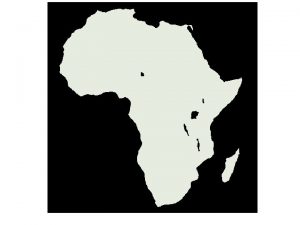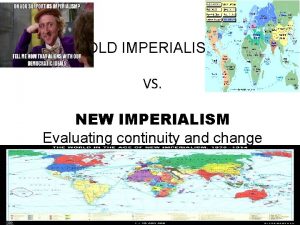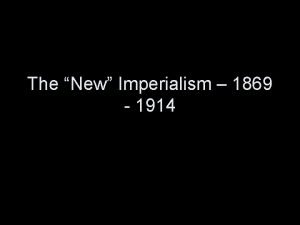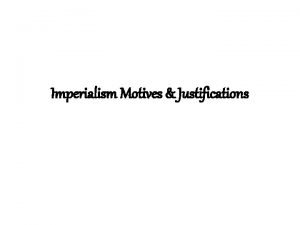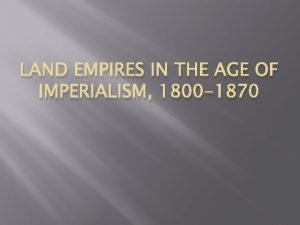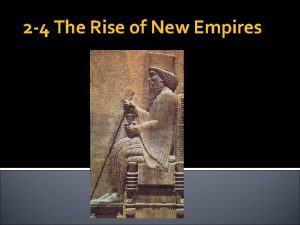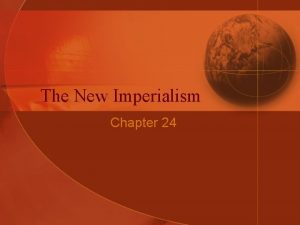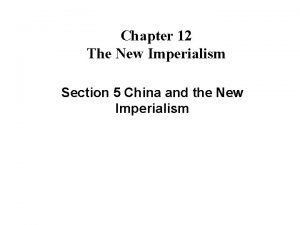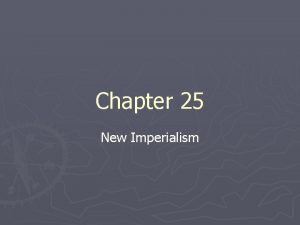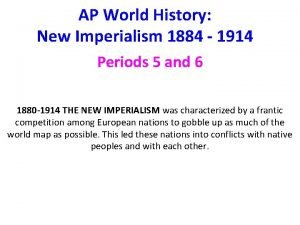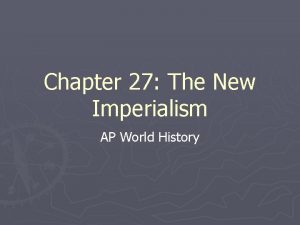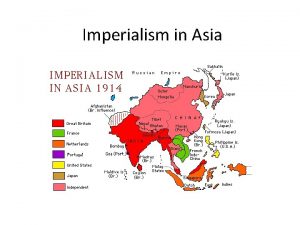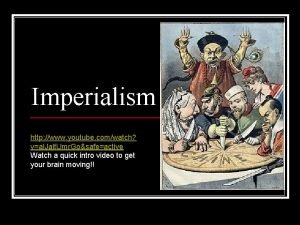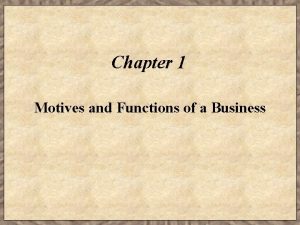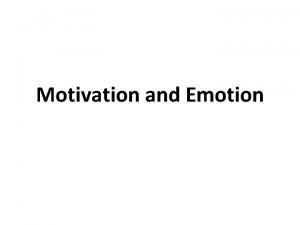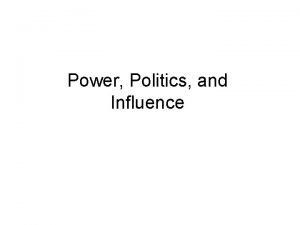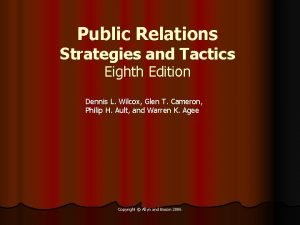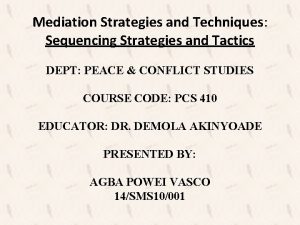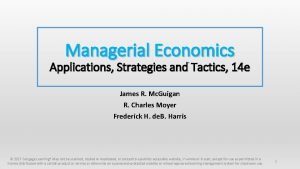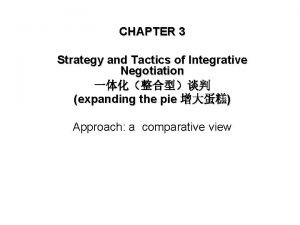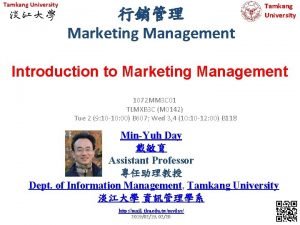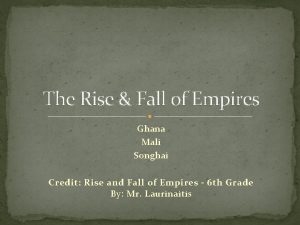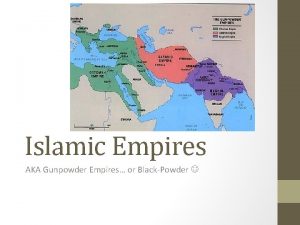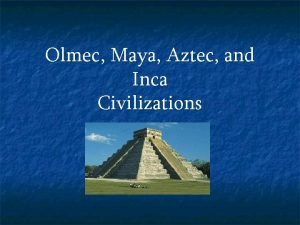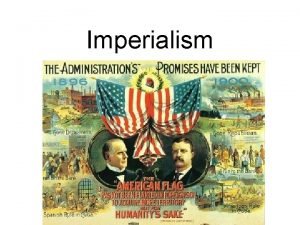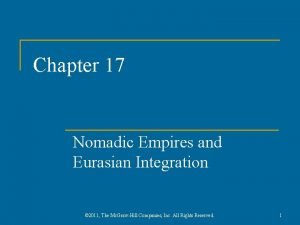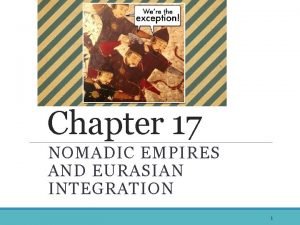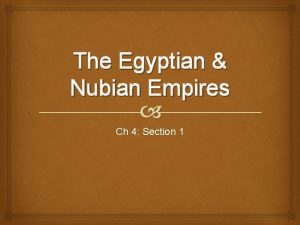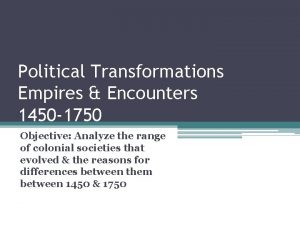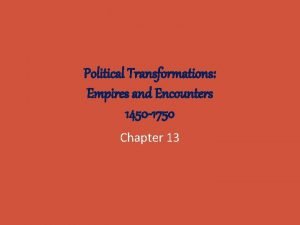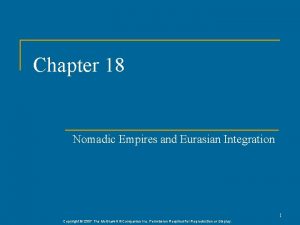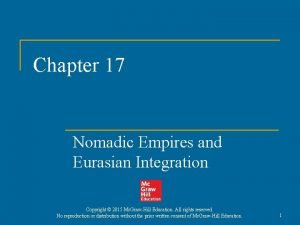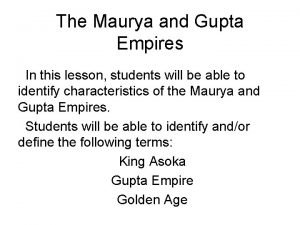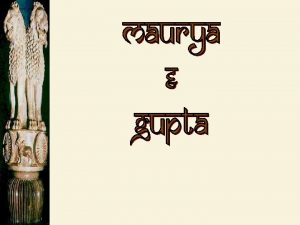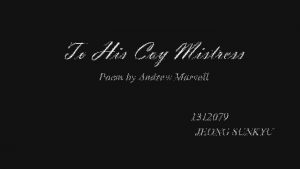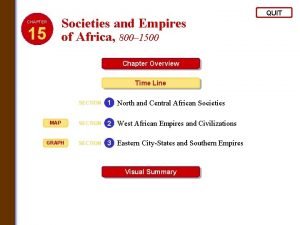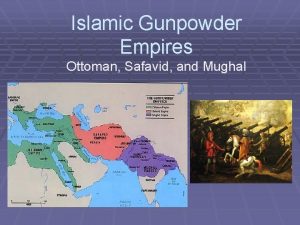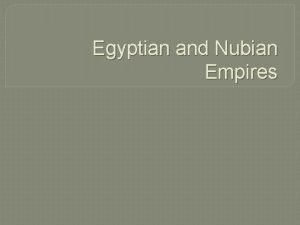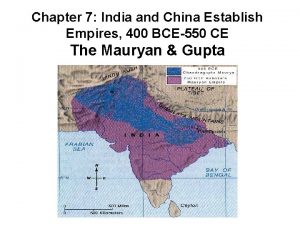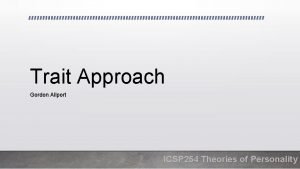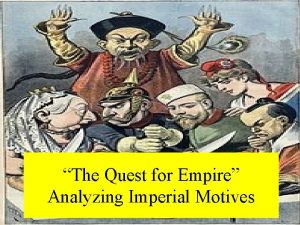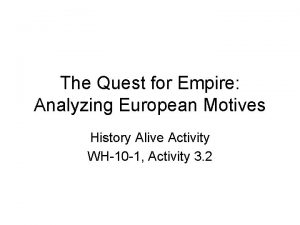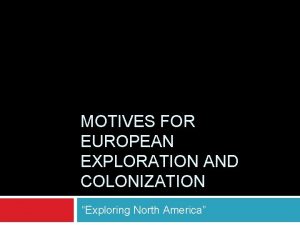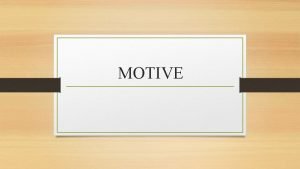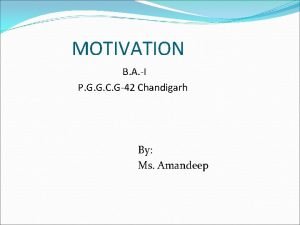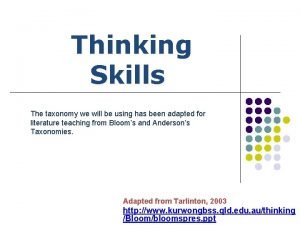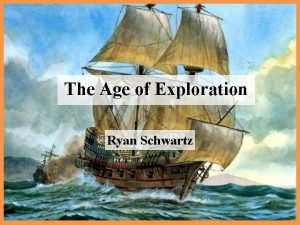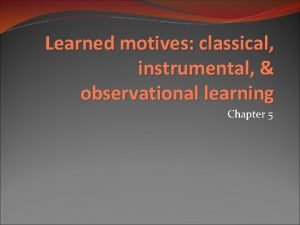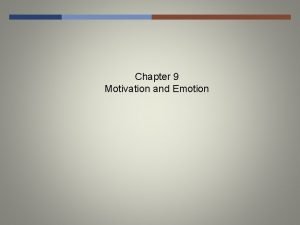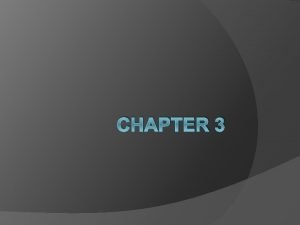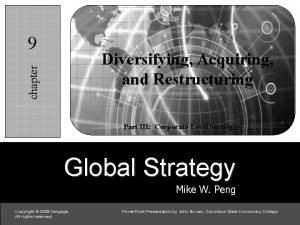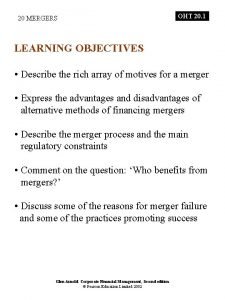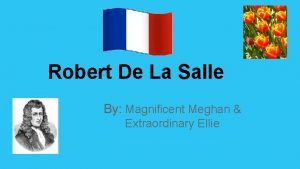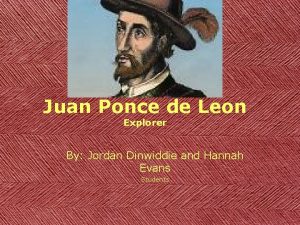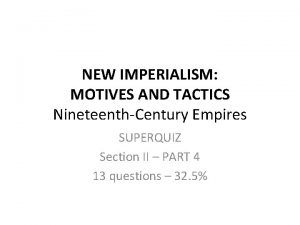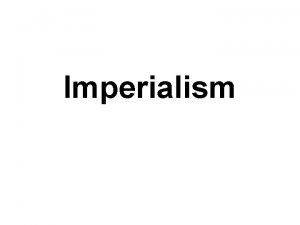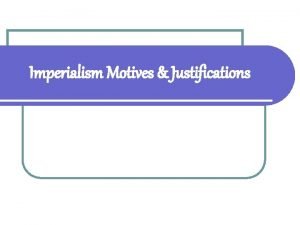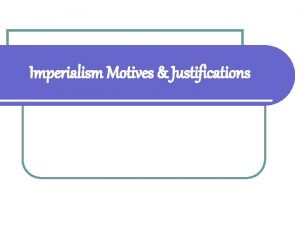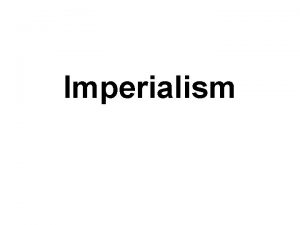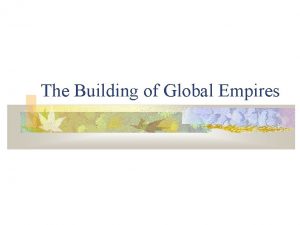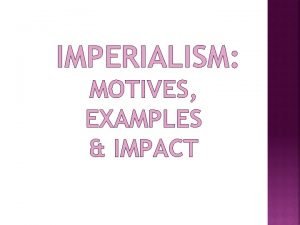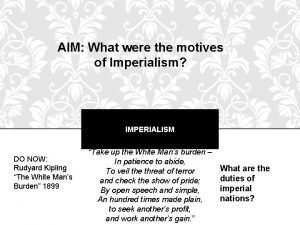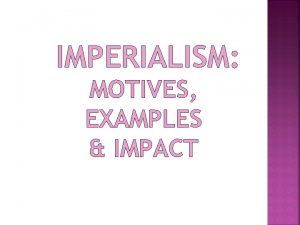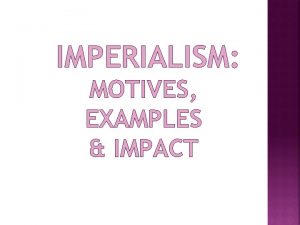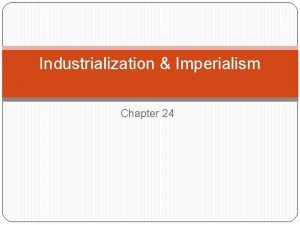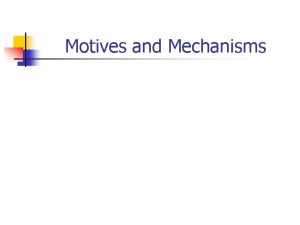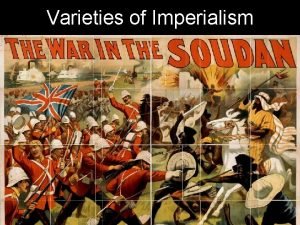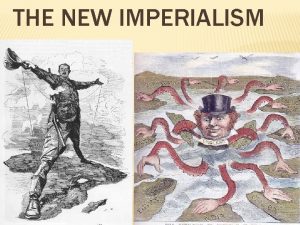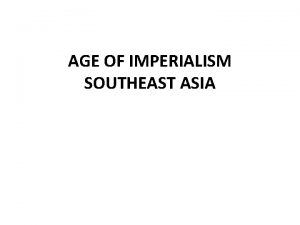NEW IMPERIALISM MOTIVES AND TACTICS NineteenthCentury Empires SUPERQUIZ










































































- Slides: 74

NEW IMPERIALISM: MOTIVES AND TACTICS Nineteenth-Century Empires SUPERQUIZ Section II 13 questions – 32. 5%

pp. 33 -39 • The Birth of the Liberal Empire • The Decline of the Mercantile Colonial World – – – External Challenges The Antislavery Movement in Europe The Influence of the Enlightenment The Free-Trade Lobby The End of European Slavery • New Sources of Colonial Legitimacy – – – The Growth of the Market Economy Enlightenment Universalism Cultural Relativism The Case of Captain Cook The Civilizing Mission in India • MACAULAY’SMINUTE

Introduction: The old “empire” • Europeans amassed New World empires beginning in the 16 th century with the ___________ Spanish conquistadors • _________formed the backbone to the African slave labor plantation economy that supported these • empires • _______ Mercantilism (econ. Sys. )ruled the New World colonies • European states engaged in trade _______ monopolies with their colonies • ______formed a moral justification for these Religion empires Missionary Europeans • ___________saved the souls of “heathens”

Empire - version 2. 0 • A ______empire replaced the religiousliberal mercantilist empire in the early 19 th century • Europeans expanded their influence overseas during the first_____(fraction) of the 2/3 th 19 _____century • This period saw very little outright European colonization ___________

Europeans focused on Asia and Africa • Merchants, missionaries, entrepreneurs, and the New World explorers largely abandoned _______ • European governments followed their citizens, Spheres of influence in Asia carving out __________ and Africa – This policy increasingly involved Europe in foreign politics

Europeans focused on Asia and Africa • Europeans saw the potential of untapped _______ markets in the non-Western world • Regions could also serve as new sources of raw materials for the ever-growing __________ European industrial economy Liberal universalism and • ___________ ENLIGHTENMENT PHILOSOPHY encouraged Europeans to bring the wonders of European civilization to new cultures

Version 3. 0: “New” and improved? “New Imperialism” • __________appeared in the late 19 th century • Competing European states engaged in expansionism aggressive_____________ • Europe conquered almost the entirety of Africa ______ as well as most of _____ Asia

Version 3. 0: “New” and improved? • Attitudes toward colonial subjects also shifted Anticolonial insurgence – _____________and ____________ biological determinism influenced beliefs regarding culture and race Darwin contributed to the –Charles ________ development of biological determinism – These occurrences --undercut the liberal aims of the early 19 th century Europeans --raised doubts regarding the feasibility of Westernizing __________ non-European peoples

Contradictions filled the dawn of the 20 th century • This time represented the peak of Europe’s _______________ global empire • Europeans also began contemplating the scope and future of empire

The Decline of the Old Empire…Overview In the late 18 th and early 19 th centuries these forces contributed to decline: • External forces: – Independence movements – Slave revolts • Internal Forces: – The rise of a market economy – cultural revolution spurred by the Enlightenment undercut the old empire’s foundations

TIMELINE: MATCHING A D F C B E • A. Hatian Revolution • B. The Great Trek – Afrikaners in South Africa • • C. British abolition of slavery D. Latin American Revolutions E. Taiping Rebellion in China F. British abolition of slave trade

TIMELINE: MATCHING C F E B A D • A. Establishment of the Indian National Congress • • • B. The Berlin Conference C. Indian Rebellion D. Sino-Japanese War E. Suez Canal opens F. Darwin publishes Origin of the Species

TIMELINE: MATCHING B A C E D • A. Fashoda Crisis • B. Ethiopians defeat Italians at Adowa • C. Boer War • D. Russo-Japanese War • E. Boxer Rebellion (China)

• EXTERNAL CHALLENGES: Slave agitation Maroon runaway slave who lived in an _______: outlaw society in South America, the Caribbean, or Spanish Florida • Maroon _________: Wars sporadic guerilla warfare against local plantations in the late 18 th and early 19 th centuries • Slave revolts cropped up – from Dutch Surinam – to British Jamaica – in the second half of the 18 th century • ______________: culmination in Saint Haitian Revolution -Domingue in 1791

Independence movements threatened European power in the New World American Revolution • The ____________kicked off these calls for independence • Many European powers lost control of their New World colonies from 1804 to 1824 • Haiti Saint-Domingue – known as ___________ – gained independence from France • Portugal lost control of _______ Brazil

Latin America Spain • Latin America captured its freedom from ______ • ______ Creole – an American-born person of European descent – these elites led the Latin American independence movements • Spain held on to these two countires: – Cuba – Puerto Rico • Influences on Latin American independence movements Enlightenment – _____________ thought – REVOLOUTIONS which served as examples: • the American Revolution • the French Revolution

Internal problems: ANTISLAVERY MOVEMENT • Organized in what 2 countries? – France – the Netherlands • Strongest campaign where? – Britain • RELIGIOUS SENTIMENT accelerated influence Protestantism the 18 th century – Newer forms of ____________in condemned slavery as a sin QUAKERISM • ___________ • Religious zealots argued that slavery ran counter to – brotherly love – Spiritual equality • Abolitionism spread to the RELIGIOUS MAINSTREAM EX. : group; notable parliamentary leader who joined = – Evangelicals – Parliamentary member William Wilberforce joined

The Enlightenment contributed to the fall of the old empire • Philosophers previously justified slavery as a – rational – efficient social and economic system • HUMANIST ________INTELLECTUAL CULTURE – John Locke condoned slavery in his 17 th century arguments • critiqued arbitrary power, • appealed to rule by reason, and • championed natural and universal human rights – 18 th and 19 th century extensions by French jurist: • Baron Montesquieu

Enlightenment universalism destabilized the acceptance of slavery • basic sameness of all humans • Compared oppressed Africans with – Disenfranchised Europeans • emphasis on the inner good undermined the European need to civilize enslaved peoples – Jean-Jacques Rousseau’s CULT OF …. • THE NOBLE SAVAGE – This work contrasted • the moral flaws of civilized Europeans with • the virtues of – THE “PRIMITIVE” • Slavery clashed with Enlightenment ideas such as the belief in the (3): – individual’s natural right to freedom, – equality before the law, and – ownership of one’s self and one’s labor

PHILOSOPHY, RELIGION, & ROMANTICISM in the late 18 th Century ROMANTICALLY • ____________oriented popular culture • Antislavery = fashionable among the European elite esp. – wealthy women • Religious emphasis on the goodness of humans – idea of a slave • as an innocent victim – the European • as a heroic savior • • Popular primitivism raised the status of the slave in the public eye Romantic poets attacked slavery and tyranny – Percy Bysshe Shelley – Robert Burns – William Wordsworth • The EUROPEAN RICH – joined abolitionist groups in the late 18 th and early 19 th centuries – signed antislavery petitions and – circulated images that exposed the cruelty of slavery

The economic rationale • Merchants and industrialists reinforced anti-slavery sentiment – wanted to replace mercantile colonialism with _______ protective tariffs free trade ; eliminate __________between • mother countries • their colonies • early 19 th century, European manufacturers objected to – European protective tariffs on foreign imports Barriers prevented domestic manufacturers from buying cheaper foreign goods • Consumers and manufacturers had to buy from either colonial producers ______ domestic or ___________ – British _____ exploited for being forced to sugar refiners felt sugar buy high-priced Jamaican raw _____(same) Tariffs shielded the Jamaican _______ sugar (same) producers from • Spanish producers in Cuba or • French producers in Saint-Domingue

ECONOMIC THEORY & PRACTICE • THEORY: Enlightenment classical economists critiqued – the slave-based economy and – mercantilism as a whole • MERCANTILISM (according to Smith and Ricardo) • irrational and inefficient system • • prevented people from pursuing their economic SELF-INTEREST MARKET COMPETITION – both rational and natural – Individuals received economic liberty and – the majority benefited from overall lower prices • Adam Smith rebuked – the inherent inefficiency of slave labor – lacked incentive to work hard and – could not be laid off in an economic slump • PRACTICE: – at the end of the 18 th century: 2 col. = real-world evidence • HAITI • JAMAICA – Economic troubles in the West Indies in the early 19 th century made the free trade claims – Merchant and industrial capitalists also experienced growing wealth and influence during this time period

The end of European slavery • The combination of – religious fervor, – humanitarian sentiment, and – economic support for free markets led to the abolition of the European slave_________ Denmark. trade • ________ first outlawed the slave trade in 1803 The U. S • ________and ________followed suit in 1807 Britain – Britain embarked on an enthusiastic antislavery mission • searching ships suspected of carrying slave cargo as well as • saving slaves along the West African coast • These 4 countries agreed to abolish the slave trade in 1815 – – Spain Portugal the Netherlands France • But they did little to eliminate it in practice • ______ Liberia – The British transported rescued slaves here – Freed American slaves helped to create this African settlement in 1821

1 st European Country to ABOLISH SLAVERY BRITAIN abolished slavery in 1834 • _____: 780, 000 – emancipated _______ slaves in the West Indies £ 20 million – government paid ______to slave owners to compensate for the lost property

Art Celebrates Abolition of Slavery in British Empire • Engraving by – DAVID LUCAS • Patterned after painting by – ALEXANDER RIPPINGILLE • Titled – “TO THE FRIENDS OF NEGRO EMANCIPATION”

End of Slavery: Europe & New World • 1848: slavery abolished in these 2 countries: – France – Denmark • European slave trade essentially ended by – 1850 • Slavery persisted in the New World through the late 19 th century • DATES - ABOLITION OF SLAVERY: – The Dutch New World : 1863 – the United States: 1865 – Spanish Cuba: 1886 – Brazil: 1888 • BUT…Freed slaves sometimes did not receive their due freedom until decades after emancipation

The Rise of New Liberal Empire • The growth of – industrial capitalism – the market economy economic ushered in new __________rationale for empire • early 19 th century - free-trade advocates – Wealth – influence • By the 1830 s, the belief in – the individual pursuit of wealth – in a free, self-regulating market as natural and efficient became part of common sense rhetoric • Economic practices occasionally contradicted this imperial _____ – 1830 to 1870, European powers competed for spheres of economic influence • This era constituted the peak era for economic liberalism – BUT… Europeans quickly abandoned ____________when indigenous peoples and other Europeans threatened their own economic interests Free trade • `

Enlightenment universalism reason social reform • The application of _____to was believed to cause human improvement • Ideas included the human biological and sameness cultural _______ – Pre-Enlightenment Europeans had emphasized the permanent between Europeans and Africans or indigenous __________cultures – 18 th century philosophers preached the similarities among human societies

Enlightenment Science • Enlightenment scientists assumed that the races of man belonged to a single _____ species SWEDISH SCIENTIST FRENCH SCIENTIST Carolus Linnaeus Georges-Louis Leclerc de Buffon _______________________ attempted to classify the variety of human physical types

Enlightenment Science • Enlightened Europeans created the idea of a common developmental path for all societies – While some societies achieved a higher level of civilization than others, all societies occupied a position on this path – This belief encouraged the idea that societal change could not only occur but could be accelerated and guided through _______________ social intervention

Cultural relativism • 19 th century Europeans = more skeptical of their supposed cultural superiority • A cultural relativism recognized the value of other societies – French Philosophe _________ Voltaire • admired ancient Chinese and Islamic civ. Gibbon – English historian Edward _________ • respected Islam – Evangelical missionaries • preached Christian brotherhood – Jean-Jacques Rousseau • New World societies as models of virtue and freedom (cult of the NOBLE SAVAGE) • Many European cultural relativists supremacy – retained the idea of their own ________ – recognized the accomplishments of other societies

Captain James Cook’s South Pacific Expeditions • Illustrate the ideology of – the new liberal empire • Cook’s motives (2) – commercial – scientific • European – exploration – expansion

Captain James Cook’s South Pacific Expeditions Pacific Ocean : the last frontier for • _______ Europeans • More than 20 (4 types of specialists) – botanists, – geographers, – ethnographers, and – scientific experts accompanied Cook • sought to the missing continent Europeans Tena Australis referred to as________

Morality of Liberal Empire Emerged in Cook’s Voyages • Justification for expansionism (2) – advancing science – further spreading civilization • Natives gained inherent rights through • universalist Cultural relativism made European explorers see the value – _________ DOCRTRINE in other societies • What respected BRIT. INSTITUTION The Royal Scientific Society – partially sponsored Cook’s South Seas voyage – cautioned Cook to treat local cultures with respect and dignity

King George III • ________authorized Cook to – establish British authority in ______in 1779 Hawaii – do so only with the explicit consent of natives • 2 main goals of colonizers in late 18 th century – legitimize their claim as civilizers – reinforced their own identities, separating themselves from previous colonial brutality

CIVILIZING INDIA India • Britain used ______ as the testing ground for civilizing experiments in the early 19 th century superstition • Evangelical missionaries sought to eliminate Indian “________” and bring about religious enlightenment. NAME 2! • • Charles Grant William Wilberforce • 4 Secular liberal reformers sought to eliminate “________” barbaric Indian laws and customs – James Mill – John Stuart Mill – Thomas Macaulay – Jeremy Bentham wanted to rid India of …. Oriental despotism wanted to introduce… British-style education

JOHN STUART MILL son of JAMES MILL

John Stuart Mill on FREE SPEECH

John Stuart Mill

John Stuart Mill

THOMAS MACAULAY • Macaulay claimed that European library” “a single shelf of a good ________ trumped “the entire native literature of [2 countries] ____________” India and Arabia • British education would cause Indians to have English (4) – – opinions morals intellect taste • Reformers held that the careful application of (3) – free trade, – education, and – law could bring Indians into the modern world

SATI Brits banned _____ • custom of widow burning herself on the funeral pyre of her husband • British viewed custom as representative of 2 things: – Indian backwardness – the moral weakness of Indian men; supposedly degraded their women instead of protecting them •

The Civilizing Mission: SATI • Title of engraving: – “The Burning System” • Date: – 1815 • One side: – Englishmen debating SATI • Other side: – musicians present for the funeral

SATI • served as a key point in the public _______reform campaign liberal upper-caste • Only certain groups of ________ Hindus actually engaged in the practice

The End of the Civilizing Mission • When? – 1857 • What? – The Indian Rebellion (Sepoy Rebellion) • Why? – Officials saw interference in Indian religion as one of the causes of the rebellion • Task of reform ceded to whom? – Indian social reformers

Thomas Macaulay • Served as – a Law Member of the Governor General’s Council • The Briton lived from – 1800 to 1859 • Macaulay represents what voice? – the British liberal voice in India • Macaulay professed his belief that these 3 things – law, – free trade, – and education could transform “backward” societies such as India

Orientalist Scholars & Administrators • early 19 th century • opposed Macaulay’s ideas • believed that India should have been ruled laws indigenous languages – in its ___________ – by its own ________

Macaulay’s Minute on Indian Education • 1835 debate English – Macaulay advocated teaching ______ instead of Arabic or Sanskrit moral values • ostensibly disseminated _________and British rule • strengthened ___________in India • English became the language of education in secondary schools across India

Let’s Review:

2. 01 JEOPARDY (pp. 33 -35) • 1. In the nineteenth century, Europeans lost their Atlantic empires and built new ones here. • 1. Where were Asia and Africa?

JEOPARDY (pp. 33 -35) • 2. The imperialist expansion of the nineteenth century was rooted economically in capitalism and philosophically in this school of thought. • 2. What is Enlightenment?

JEOPARDY (pp. 33 -35) • 3. France lost control here in 1804. • 3. Where is Haiti?

JEOPARDY (pp. 33 -35) • 4. American-born people of Europeans descent who led the revolutions in Latin America were called this. • 4. What are Creoles?

JEOPARDY (pp. 33 -35) • 5. These two revolutions served as examples to later revolutions in Haiti, Brazil, and other parts of Latin America. • 5. What are the French and American Revolutions?

JEOPARDY (pp. 33 -35) • 6. Runaway slaves were called this. • 6. What are maroons?

JEOPARDY (pp. 33 -35) • 7. Abolitionist campaigns were waged in places like the Netherlands and France but the most effective was held here. • 7. Where is Britain?

JEOPARDY (pp. 33 -35) • 8. Some of the strongest opponents to slavery were Protestants, especially from newer forms of Protestantism like this one. • 8. What is Quakerism?

JEOPARDY (pp. 33 -35) • 9. This Enlightenment writer wrote of natural and human universal rights but did condone slavery • 9. Who was John Locke?

JEOPARDY (pp. 33 -35) • 10. This Enlightenment philosopher wrote of the noble savage, highlighting the virtues of the “savage” and the lack of morality found in civil society. • 10. Who is Jean-Jacques Rousseau?

2. 02 COMMONALITIES (PP. 33 -35) • William Wordsworth • Percy Shelley • Robert Burns • ROMANTIC POETS

2. 02 COMMONALITIES (PP. 33 -35) • Adam Smith • David Ricardo • Enlightenment Classical Economists

2. 02 COMMONALITIES (PP. 33 -35) • Being anti-slavery became fashionable • Enlightenment ideas like natural rights • Merchants sought t replace mercantilist colonial system • Factors contributing to the ABOLITIONIST movement

2. 02 COMMONALITIES (PP. 33 -35) • Carolus Linnaeus • Georges-Louis Leclerc de Buffon • Natural Scientists

2. 02 COMMONALITIES (PP. 33 -35) • William Wilberforce • Charles Grant • Anti-slavery evangelical missionaries

2. 02 COMMONALITIES (PP. 33 -35) • • Dennis Diderot John Locke Jean-Jacques Rousseau Montesquieu • Enlightenment writers

2. 02 COMMONALITIES (PP. 33 -35) • • Jeremy Bentham John Mill John Stuart Mill Thomas Macaulay • Secular liberal reformers

Fill-ins, pp. 37 -38 • 1. Thomas Macaulay was the Law Member of the Council and ________ Governor General’s ________ an important example of the British __________voice in India. liberal

Fill-ins, pp. 37 -38 • 2. Macaulay believed that the way to civilize and backwards transform a “________” culture like India’s was through education, specifically the introduction law _______, free trade and_____. education of ______, • He saw this as necessary to disseminate moral values as well as maintain and ________ strengthen British _____ rule in India.

Fill-ins, pp. 37 -38 Orientalist scholars disagreed with liberals • 3. ________ like Macaulay and thought that India should be ruled by its own laws and through indigenous ________ institutions and languages.

Fill-ins, pp. 37 -38 • 4. Macaulay writes that Indians should be taught English because it “stands ___________ Pre-eminent even among the languages of the west” and because “it abounds with works of __________. ” imagination

Fill-ins, pp. 37 -38 historical • 5. According to Macaulay, the _________ compositions written in English have “seldom been narratives and “never been surpassed” as _______ ethical equaled” as “vehicles of __________ and political instruction. ”

Fill-ins, pp. 37 -38 • 6. Macaulay points out in his article that even in India ruling the language of the __________ class is English.

Fill-ins, pp. 37 -38 • 7. Macaulay argues that, since the British can’t educate all Indians, the goals should be to educate a class of people who would “be _________ interpreters between [the British] and the millions” of Indians they govern. The class would be “Indian in ______ blood and colour, but English in ________, in opinion, in morals, and in taste intellect. ”

STOP
 New imperialism motives
New imperialism motives Old imperialism vs. new imperialism
Old imperialism vs. new imperialism Land empires vs maritime empires
Land empires vs maritime empires Imperialism motives
Imperialism motives Ivory
Ivory Land empires in the age of imperialism
Land empires in the age of imperialism Guided reading activity 2-4 the rise of new empires
Guided reading activity 2-4 the rise of new empires Chapter 24 section 5 china and the new imperialism
Chapter 24 section 5 china and the new imperialism Chapter 12 section 5 china and the new imperialism
Chapter 12 section 5 china and the new imperialism Marx on imperialism
Marx on imperialism New imperialism africa
New imperialism africa New imperialism africa
New imperialism africa World history
World history Monroe doctrine cartoon meaning
Monroe doctrine cartoon meaning Imperialism
Imperialism Economic causes of new imperialism
Economic causes of new imperialism European imperialism in asia
European imperialism in asia Causes of new imperialism
Causes of new imperialism Lesson 1: the new imperialism
Lesson 1: the new imperialism The patterns of feelings motives and behavior
The patterns of feelings motives and behavior Motives and functions of a business
Motives and functions of a business Examples of emotions vs feelings
Examples of emotions vs feelings Factors contributing to organizational politics
Factors contributing to organizational politics Hhhnhhh
Hhhnhhh Function of public relations
Function of public relations Sequencing strategies and tactics
Sequencing strategies and tactics Broker pattern
Broker pattern Managerial economics applications strategy and tactics
Managerial economics applications strategy and tactics Strategy and tactics of integrative negotiation
Strategy and tactics of integrative negotiation Business tactics
Business tactics Integrating communications assessment and tactics
Integrating communications assessment and tactics Imperyong ghana meaning
Imperyong ghana meaning How did the ottoman safavid and mughal empires arise
How did the ottoman safavid and mughal empires arise Mayan aztecs and incas
Mayan aztecs and incas The policy of establishing colonies and building empires
The policy of establishing colonies and building empires Chapter 17 nomadic empires and eurasian integration
Chapter 17 nomadic empires and eurasian integration Nomadic empires and eurasian integration
Nomadic empires and eurasian integration Chapter 4 section 1 the egyptian and nubian empires
Chapter 4 section 1 the egyptian and nubian empires Political transformations empires and encounters
Political transformations empires and encounters Chapter 5 political transformations empires and encounters
Chapter 5 political transformations empires and encounters Gunpowder empires characteristics
Gunpowder empires characteristics Chapter 18 nomadic empires and eurasian integration
Chapter 18 nomadic empires and eurasian integration Chapter 17 nomadic empires and eurasian integration
Chapter 17 nomadic empires and eurasian integration Chapter 16 people and empires in the americas
Chapter 16 people and empires in the americas The maurya and gupta empires
The maurya and gupta empires The maurya and gupta empires
The maurya and gupta empires Venn diagram of mauryan and gupta empires
Venn diagram of mauryan and gupta empires To his coy mistress poem analysis
To his coy mistress poem analysis Indias first empire
Indias first empire Chapter 15 societies and empires of africa
Chapter 15 societies and empires of africa Impaler state of decay 2
Impaler state of decay 2 The egyptian and nubian empires
The egyptian and nubian empires Chapter 7 india and china establish empires
Chapter 7 india and china establish empires Propriate motives
Propriate motives Imperial motives
Imperial motives Leading motives quest
Leading motives quest What is personnel security
What is personnel security What were the motives for european exploration
What were the motives for european exploration Secondary motive
Secondary motive Types of motives in psychology
Types of motives in psychology What is buying motive
What is buying motive Uncovering motives hots
Uncovering motives hots Vasco nunez de balboa motives for exploration
Vasco nunez de balboa motives for exploration Naked asci
Naked asci Learned motives
Learned motives Interior motives nj
Interior motives nj Chapter 9 motivation and emotion
Chapter 9 motivation and emotion Patronage motives
Patronage motives Ponce de leon motives for exploration
Ponce de leon motives for exploration Motives for colonizing plymouth
Motives for colonizing plymouth Motives for diversification
Motives for diversification Motives of merger
Motives of merger Robert de lasalle facts
Robert de lasalle facts Juan ponce de leon impact
Juan ponce de leon impact Juan ponce de leon routes
Juan ponce de leon routes
